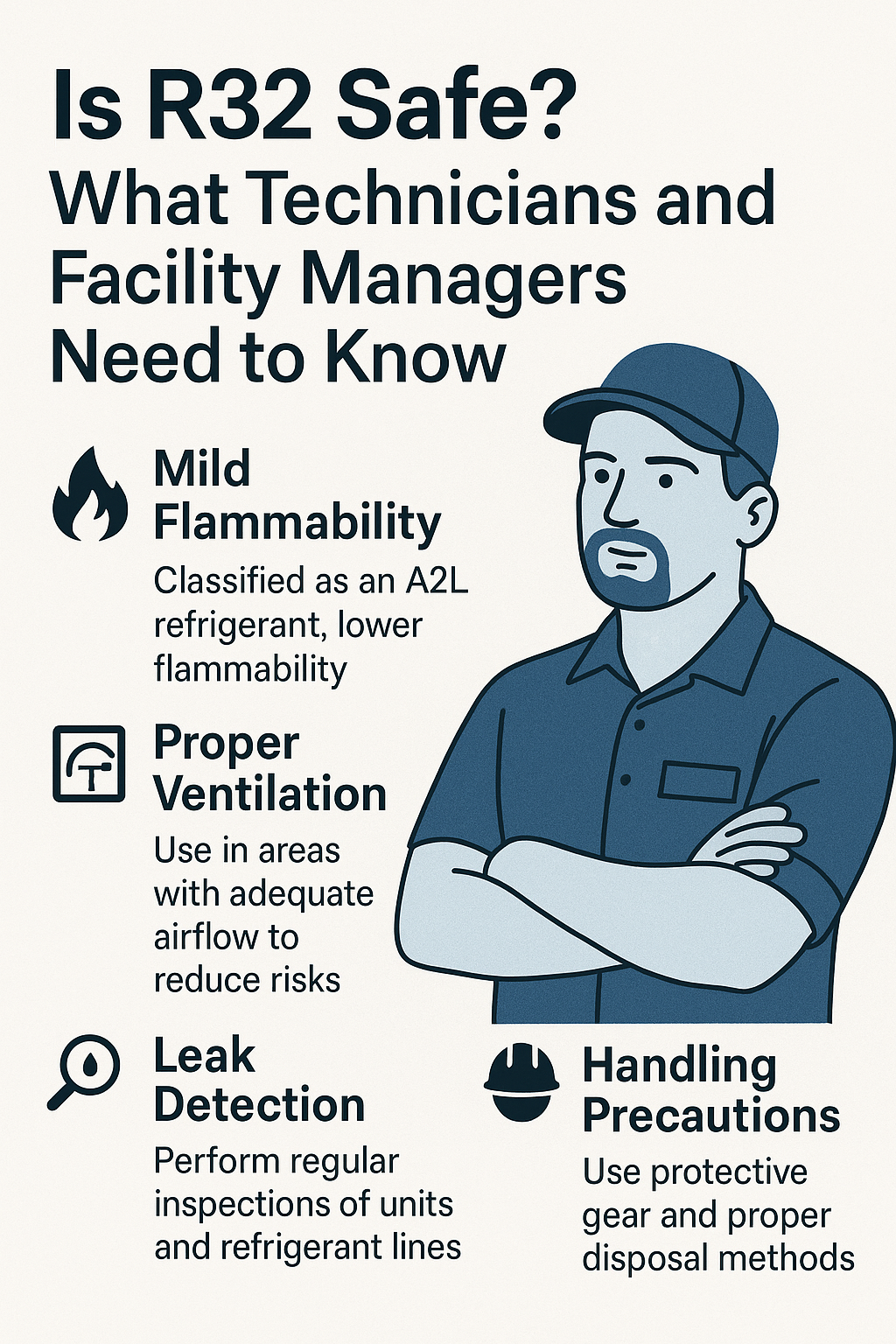Quick Answer for Busy Techs
Yes, R32 is safe — when installed and handled properly.
If you’ve got experience with R410A or R22, you’ll find R32 PTAC units just as straightforward, with a few extra safety notes worth remembering.
Whether you’re a facility manager concerned about liability or a technician wondering what’s changed, this guide lays out the facts — without the fluff.
🧪 What’s “Mildly Flammable” Really Mean?
You’ve probably heard it already: R32 is classified as A2L — non-toxic and mildly flammable. So let’s break that down.
| ASHRAE Rating | Toxicity | Flammability | Example |
|---|---|---|---|
| A1 | No | No | R410A |
| A2L | No | Mild | R32 |
| B2 | Yes | Mild | Ammonia (NH₃) |
A2L means:
-
It ignites slowly, only under very specific conditions
-
It requires a high concentration and a strong ignition source
-
In normal PTAC operations, those conditions don’t happen
🧯 Bottom line: It’s not like propane. It’s much more stable.
🏢 Real-World Risk: Practically Zero in Packaged Units
Let me give it to you straight from the field. In sealed PTAC units, you’re talking about:
-
Pre-charged systems: R32 is sealed at the factory, reducing exposure risk.
-
Small refrigerant charge: Usually under 1 pound — far below flammability concern thresholds.
-
Built-in safety features: These units come with pressure relief valves, leak sensors, and flame-retardant casing.
🏨 Whether you’re installing in a hotel room, assisted living suite, or university dorm, R32 PTACs are safe for both guests and maintenance staff.
⚙️ For Technicians: Safe Handling Tips
While the risk is low, here’s what I always recommend:
✅ Use a recovery machine approved for A2L refrigerants
✅ Avoid open flames and hot work near refrigerant lines
✅ Ensure good ventilation when charging or recovering
✅ Keep a halogen leak detector on your truck
✅ Review your MSDS (Material Safety Data Sheet) for R32 periodically
🎒 Bonus: Carry a spark-free inspection light — small investment, big peace of mind.
🧾 For Facility Managers: What to Know Before Buying
If you’re managing a commercial or multi-unit property, your main concerns are compliance, longevity, and tenant safety. Here’s what I tell clients:
-
Code compliant: R32 is approved under EPA’s SNAP program and meets ASHRAE 15 safety standards.
-
Energy efficient: These units typically consume 10–15% less energy than R410A models.
-
Lower total refrigerant charge: Less refrigerant = lower environmental risk.
You’re not just buying a safe unit — you’re investing in long-term efficiency and compliance.
🚨 Common Myths — Busted
"R32 will explode if it leaks."
Nope. It’s mildly flammable, not explosive. You’d need a confined space, a leak, and an ignition source all at once.
"You need a special license to work with R32."
False. You just need your EPA 608 cert and to follow A2L guidelines.
"It’s not safe for residential properties."
Wrong again. It’s ideal for PTAC units in residential and light commercial settings.
🏁 Wrapping It Up
R32 is just as safe — if not safer — than the old-school stuff, and it’s better for the planet too. The key is education and smart practices.
🧰 For techs: stay sharp, get familiar with A2L handling.
📋 For managers: choose models with built-in safety and EPA compliance (like the ones at The Furnace Outlet).
Still unsure? Reach out — I’m always happy to help break down the specs or walk through installation prep.







